Physical Address
304 North Cardinal St.
Dorchester Center, MA 02124
Bone-forming tumors of the skeletal system represent a broad spectrum of neoplasms that vary significantly in their morphology and biologic potential. They are defined as neoplasms that arise within or on the surface of a bone in which the neoplastic cells synthesize and secrete the organic components of bone matrix, which may or may not undergo subsequent mineralization. Neoplastic cells have the phenotype of osteoblasts and are intimately associated with newly formed matrix. Neoplastic osteoblasts are large, polyhedral, and have a moderate-to-abundant amount of eosinophilic cytoplasm. The nuclei tend to be eccentric in location, polarized away from the bone-forming surface, and have fine chromatin and prominent nucleoli. Tumor cells entrapped within the matrix are frequently smaller than those lining the surface of the neoplastic bone and are similar in appearance to non-neoplastic osteocytes, a phenomenon known as normalization . This constellation of cytologic features, however, varies with the degree of differentiation of the tumor. In indolent tumors such as osteoma and bone island the osteoblasts lining the bone surfaces are quiescent in appearance and are elongate, flat with thin nuclei, and inconspicuous cytoplasm.
The growth pattern of the bone-forming tumor (circumscribed or infiltrative) and the architecture of the neoplastic bone (cortical or trabecular/woven or lamellar) also correlate with the nature of the tumor. Benign tumors are usually well circumscribed, and the bone matrix is typically deposited as trabeculae of woven or lamellar bone, whereas osteosarcoma grows with an infiltrative pattern, and the bone is woven in architecture and deposited in a coarse, lace-like pattern. Cortical type bone is distinctly uncommon in bone tumors, with the notable exceptions of osteomas and bone island (enostoses), and lamellar bone is rarely present in osteosarcoma.
The morphologic heterogeneity of bone-forming tumors makes their diagnosis notoriously difficult. Because treatment may vary from observation to en bloc excision with neoadjuvant therapy, careful correlation of tumor morphology with clinico-radiographic features is paramount for accurate diagnosis and appropriate clinical management.
Bone island (enostosis) is a benign, bone-forming tumor composed of cortical-type bone, which involves the medullary cavity. The true incidence is unknown as it is most commonly detected as an incidental radiographic finding. Its prevalence in pelvic bones and ribs has been reported to be 1.08% and 0.43%, respectively, and some investigators indicate that 3% to 4% of the population has a bone island in their skeleton. Bone islands have been identified in all age groups, although they are reported to be fairly uncommon in children and have no sex predilection. The pelvis, proximal femur, and ribs are the most frequently involved sites. Within tubular bones, they usually involve the epiphyses. Clinically, bone islands are asymptomatic, with only exceptional cases causing pain.
Osteopoikilosis is a syndrome that may be inherited in an autosomal dominant fashion and is caused by a loss-of-function mutation in the LEMD3 gene, which encodes a nuclear envelope protein involved in the regulation of the transforming growth factor beta (TGF-beta) and bone morphogenic protein (BMP) pathways. Some patients may also have melorheostosis and Buschke–Ollendorff syndrome. Clinically, the disorder is characterized by the presence of innumerable bone islands, which are bilateral, symmetric, and most frequently involve the metaphyseal and epiphyseal regions of tubular bones, carpal, and tarsal bones, and the flat bones of the proximal limb girdles. Radiographically, macroscopically, and histologically, they are identical to sporadic, solitary bone islands.
Bone islands have characteristic radiographic features. On plain films they appear as small, round, homogeneously radiodense lesions that have spiculated margins that merge with surrounding cancellous bone ( Fig. 16.1 ). The lesions, particularly those which are large in size, may abut or arise in association with the endosteal surface; however, they do not involve the cortex and do not elicit a periosteal reaction ( Fig. 16.2A ). On computed tomographic (CT) scans, bone islands appear identical to cortical bone ( Figs. 16.2B and 16.3 ). On magnetic resonance imaging (MRI), they have low signal intensity giving them a dark appearance and, on bone scan, they absorb little-to-no tracer and are referred to as “cold.”
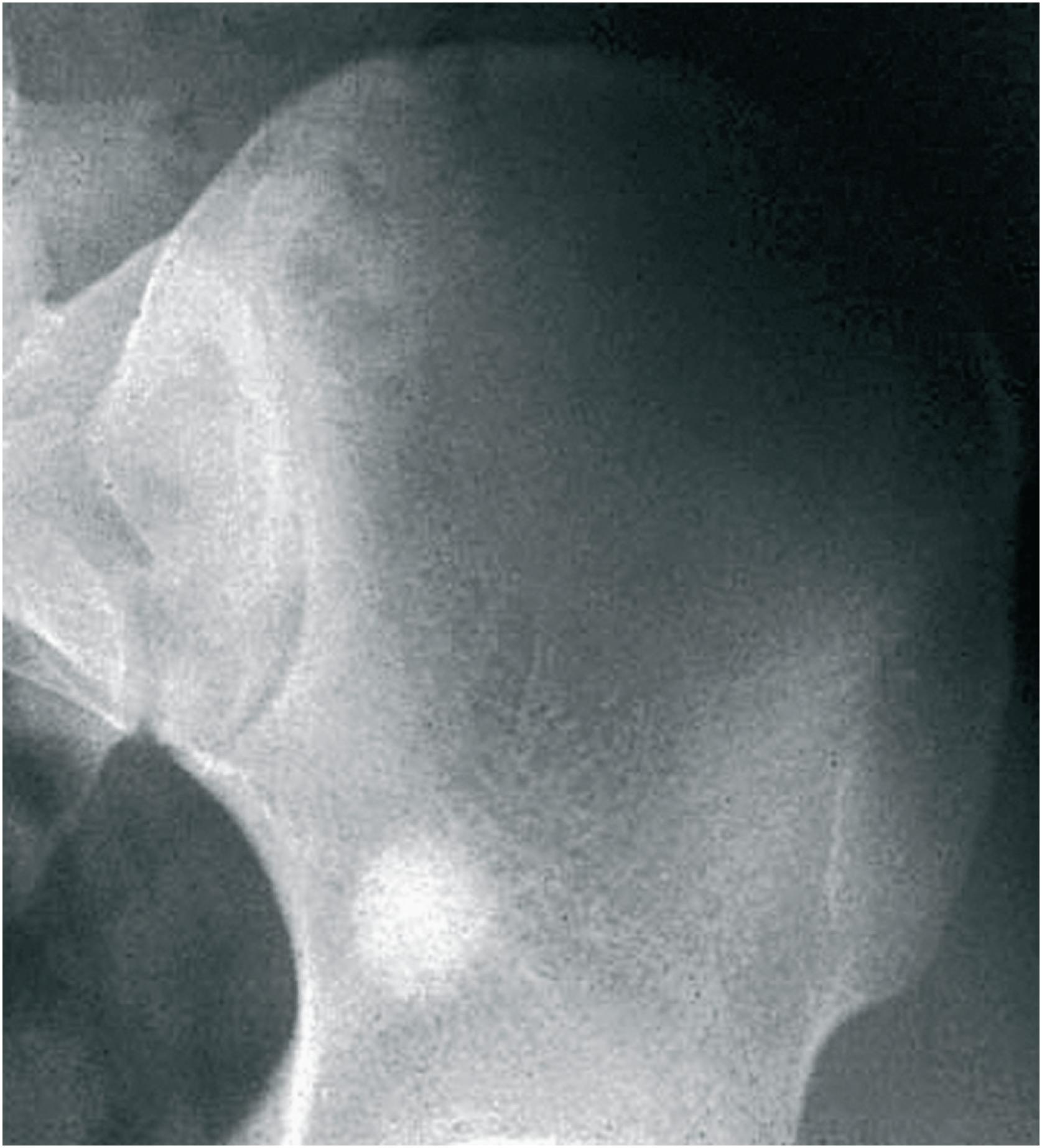
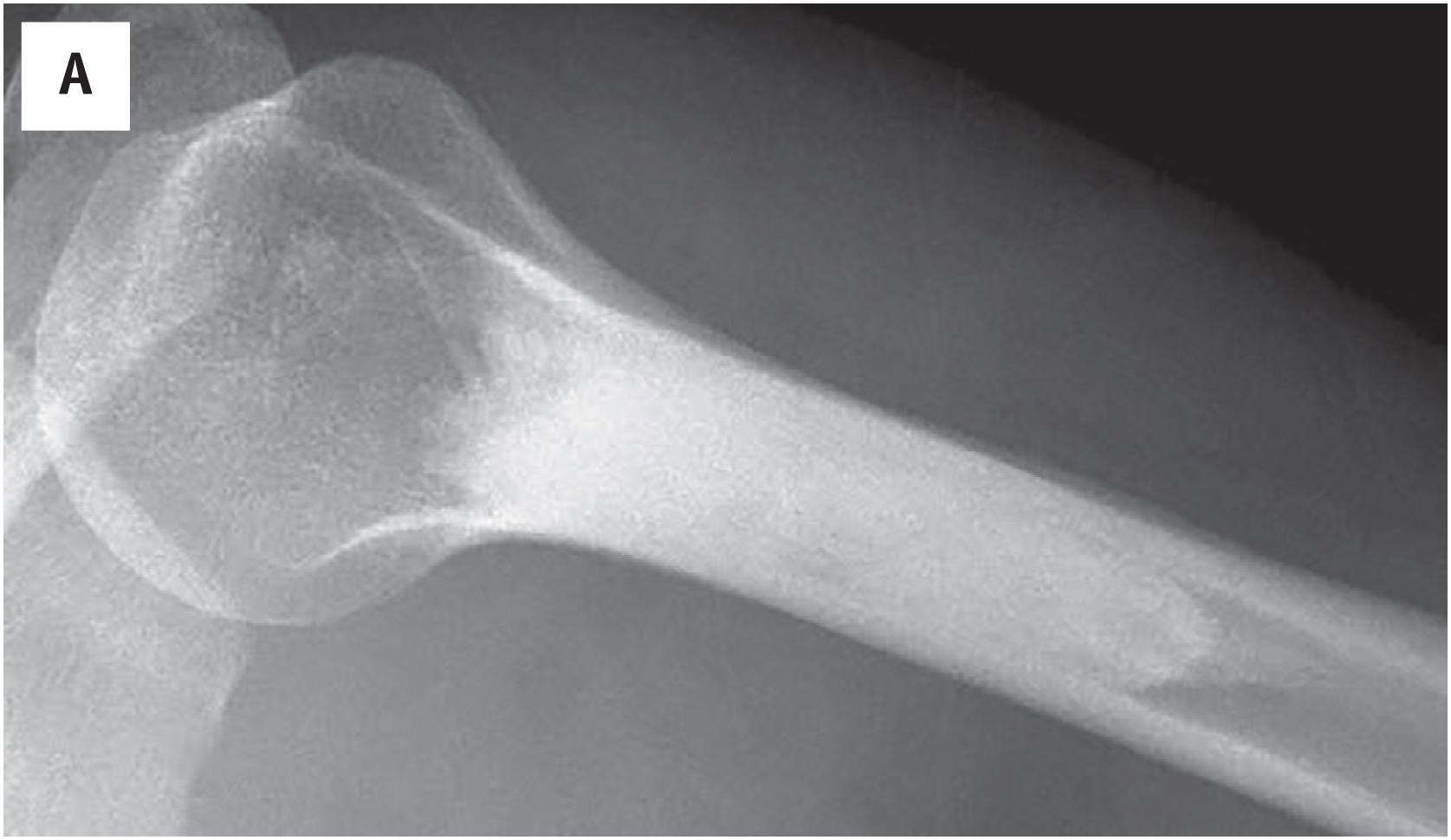
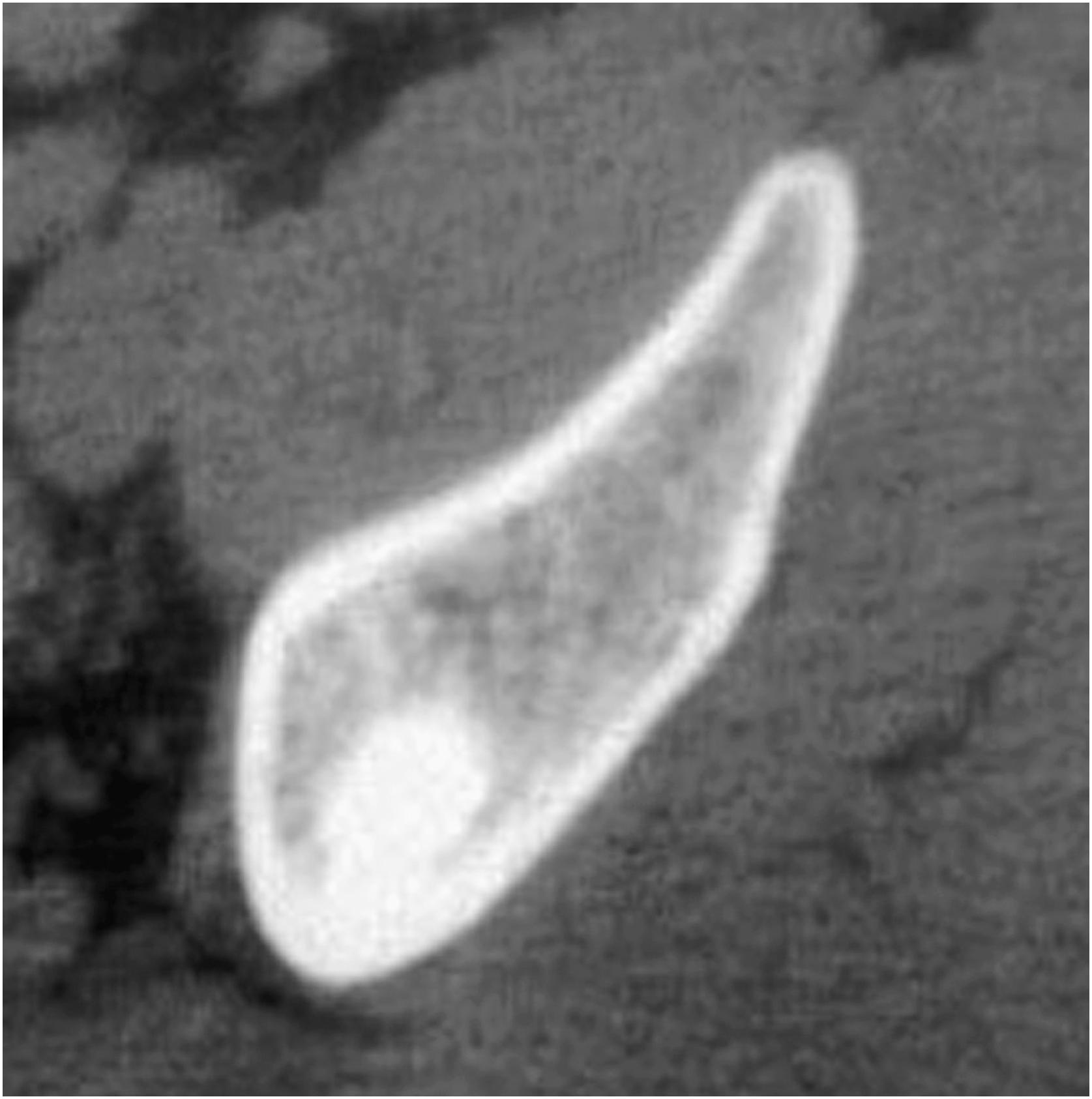
Grossly, bone islands arise within the medullary cavity, are generally not much larger than 1 cm in diameter, and are hard, solid, and tan-white. Their periphery merges seamlessly into surrounding cancellous trabeculae.
Histologically, bone islands consist of cortical-type bone that is predominately lamellar, may be focally woven, and contains Haversian-like canals ( Fig. 16.4 ). The osteoblasts lining the bone surfaces are flat and quiescent, and the osteocytes are small and cytologically banal. Lesional bone at the periphery merges almost imperceptibly into pre-existing lamellar bone ( Fig. 16.5 ).
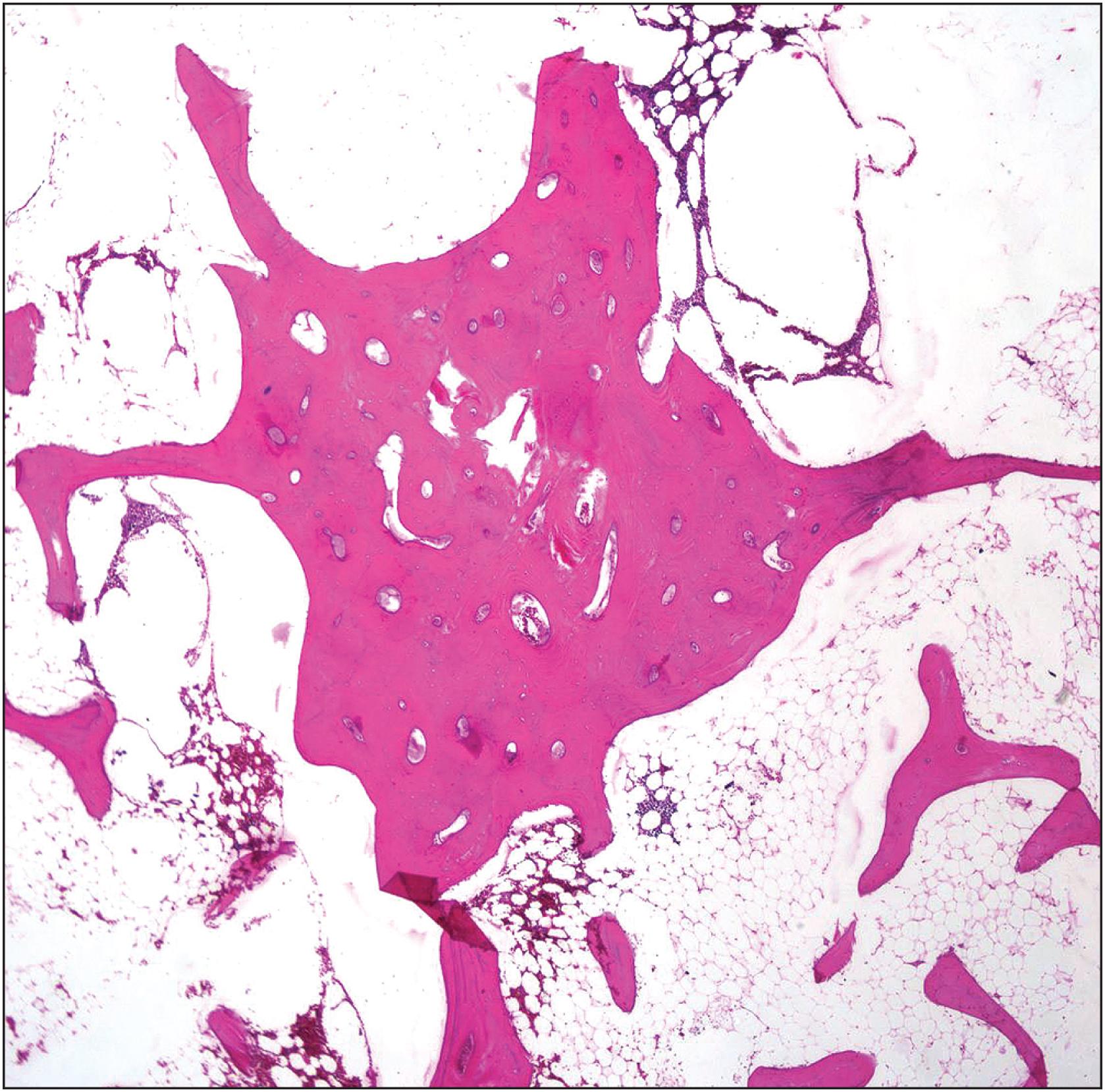
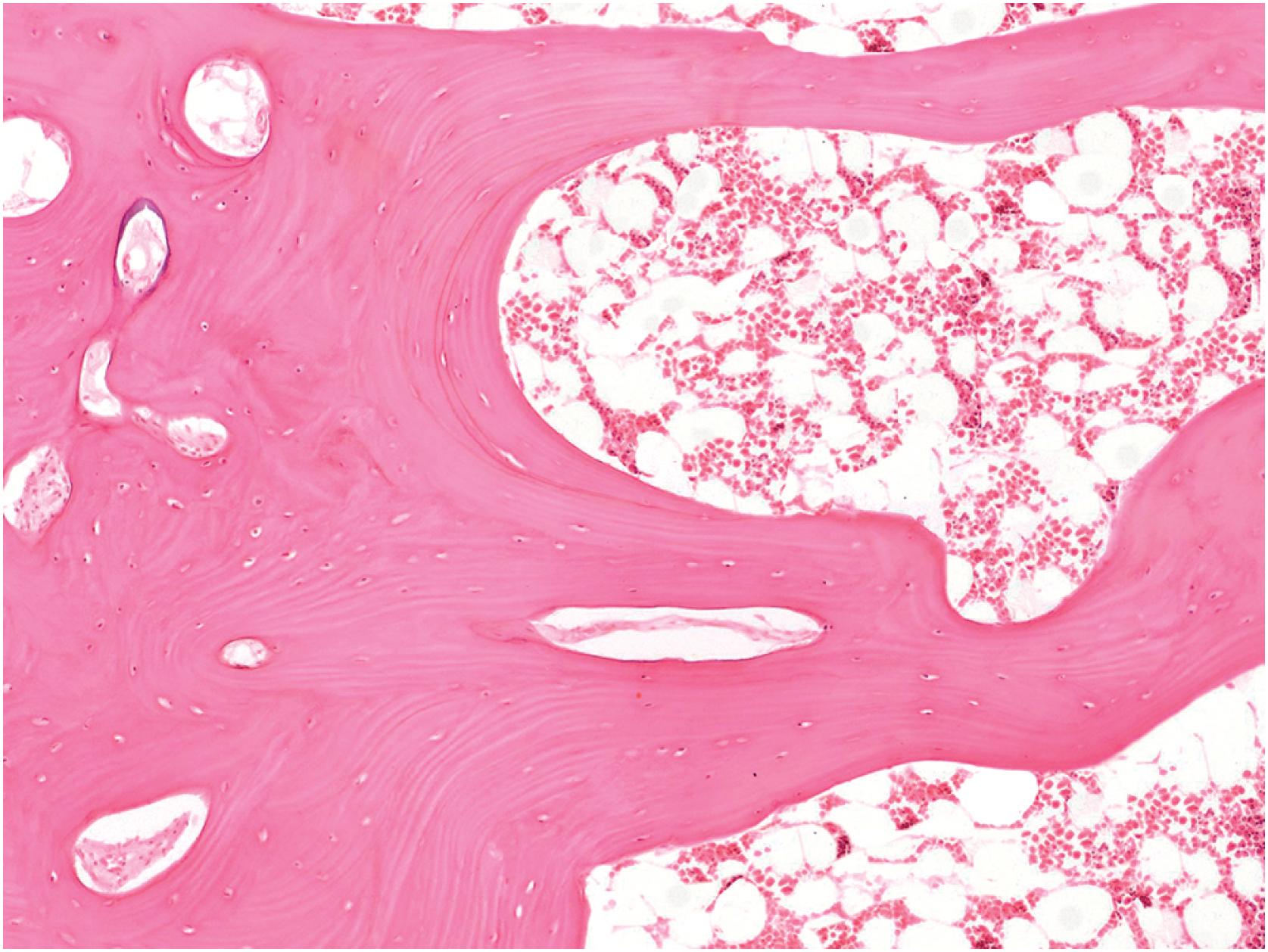
The most important differential diagnostic consideration is intramedullary well-differentiated osteosarcoma. In contrast to bone island, intramedullary well-differentiated osteosarcoma is infiltrative, the bone is usually trabecular rather than cortical, and the neoplastic matrix is surrounded by a monotonous population of proliferating spindle cells rather than a single layer of quiescent surface osteoblasts. While the distinction is usually a morphologic one, in small biopsies or samples with adjacent fibrosis, it could rarely be helpful to assess for the presence of MDM2 amplification by in situ hybridization (ISH) or immunohistochemistry (IHC), which is often seen in intramedullary well-differentiated osteosarcoma and not enostoses.
Another lesion that may enter the differential is an osteoblastic metastasis. In contrast to an enostosis, the newly formed bone in an osteoblastic metastasis is trabecular and generally surrounds islands of carcinoma cells that are cytologically malignant and morphologically different from the osteoblasts seen in bone islands.
Benign bone-forming tumor composed of cortical-type bone
Osteopoikilosis is a syndrome characterized by innumerable bone islands
Frequency is unknown because it is a frequent incidental finding
Pelvis, proximal femur, and ribs are most common locations
Bone island is benign
Male and female sexes are affected with equal frequency
Identified in all age groups but rare in children
Usually asymptomatic and incidental finding
Rarely causes pain
Radiodense lesion(s) that are spiculated and merge with the surrounding cancellous bone
Osteopoikilosis – autosomal dominant; loss-of-function mutation in LEMD3
No is treatment necessary
Biopsy sometimes performed on large bone islands to exclude a low-grade osteosarcoma or sclerotic metastases
Spiculated, dense, solid, and tan-white
Cortical-type bone that is spiculated and blends with the surrounding cancellous bone
Osteoblasts and osteocytes express SATB2, RUNX2, and Osterix, although this finding is not helpful in the main differential diagnosis
In situ hybridization (ISH) does not demonstrate amplification of MDM2, in contrast to intramedullary well-differentiated osteosarcoma
Intramedullary well-differentiated osteosarcoma
Osteoblastic metastasis
Bone islands usually do not require treatment, as they are indolent and typically asymptomatic. They may undergo remodeling, altering the radiographic appearance of the lesion; however, they do not undergo biologic transformation to a more aggressive process. Rare cases, particularly those presenting as larger lesions, may require biopsy to exclude a more aggressive neoplasm such as well-differentiated osteosarcoma or sclerotic metastasis. Lesions which are excised may rarely recur.
Osteoma is a benign, bone-forming tumor that arises on the cortical surface. The majority of tumors are composed of mature, compact, cortical-type bone; however, rare cases may be composed of cancellous-type bone. They usually develop on the surface of the craniofacial skeleton and have a particular propensity to involve the bones of the paranasal and frontal sinuses and the orbit where they are found in 1% to 3% of the adult population. Rarely, osteomas are located in the vertebral column or the appendicular skeleton where they develop on the surfaces of long tubular bones. They have a slight male predilection and are typically diagnosed during mid-adulthood. Osteoma is usually solitary but may be multiple in a minority of cases. Importantly, the diagnosis of osteoma in a young patient or multiple osteomas should raise suspicion for the presence of Gardner syndrome, an autosomal dominant intestinal polyposis syndrome caused by mutations in the adenomatous polyposis coli (APC) tumor suppressor gene and associated with a predisposition for colorectal adenocarcinoma, osteomas, dental anomalies, epidermal inclusion cysts, congenital hypertrophy of the retinal pigment epithelium, and various soft tissue tumors.
Craniofacial osteomas are commonly asymptomatic and detected as incidental radiographic findings. Larger tumors, however, may cause cosmetic issues such as swelling and facial asymmetry in addition to symptoms secondary to sinus obstruction, including discharge and mucocele formation. Orbital osteomas can induce a variety of secondary symptoms, including dacryocystitis, exophthalmos, and diplopia. Tumors involving the spinal column may be complicated by spinal cord or nerve compression, and those developing in the extremities can present as a palpable, possibly painful, mass.
Osteomas are usually round-to-ovoid, uniformly radiodense, sharply demarcated, and have a broad base of attachment to the cortical bone surface ( Figs. 16.6 and 16.7 ). On CT and MRI, osteomas most often manifest as well-delineated, surface-based masses composed of cortical-type bone; however, the cancellous variant demonstrates characteristics of trabecular-type bone with intervening adipose tissue ( Fig. 16.8 ).
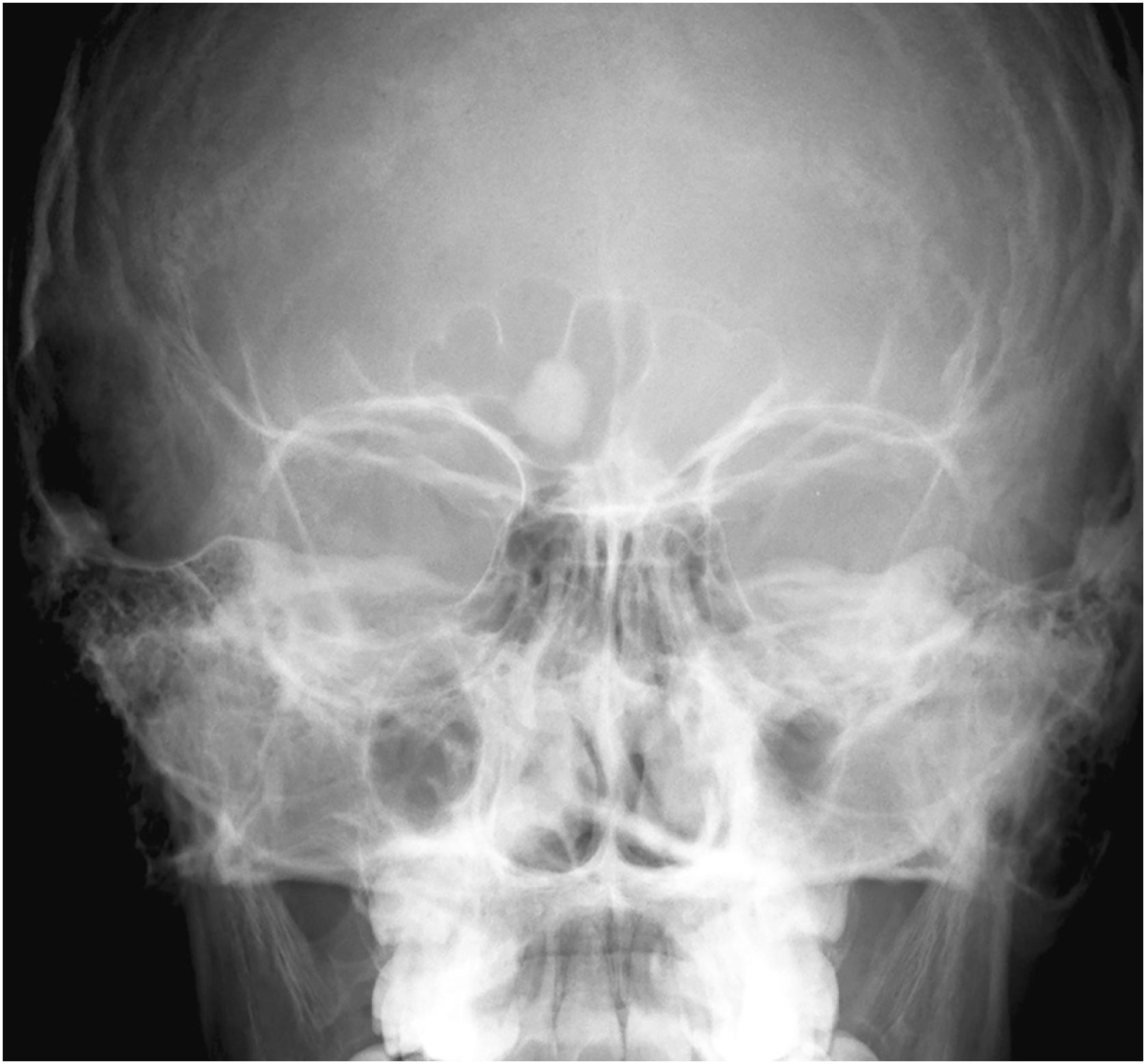
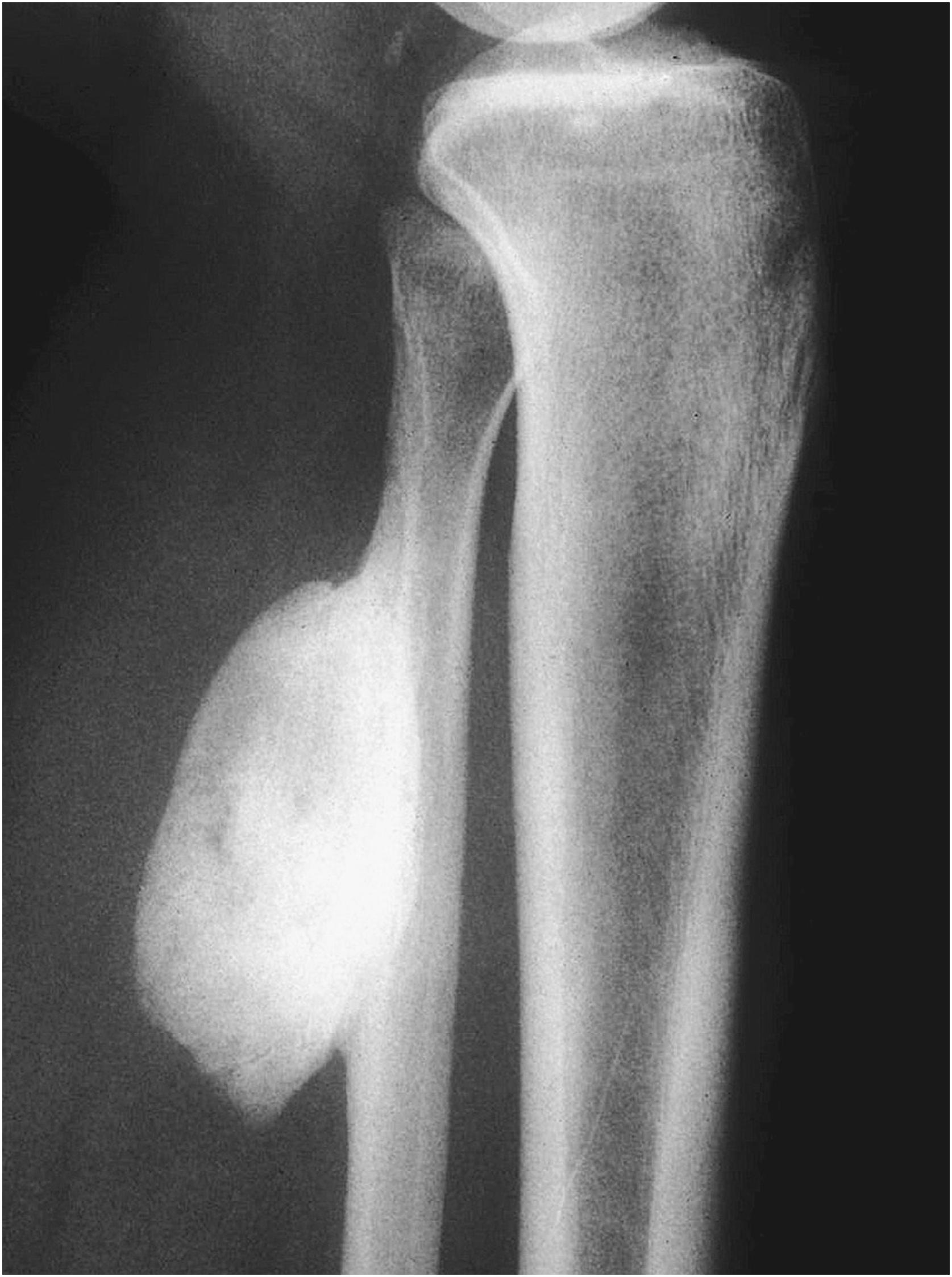
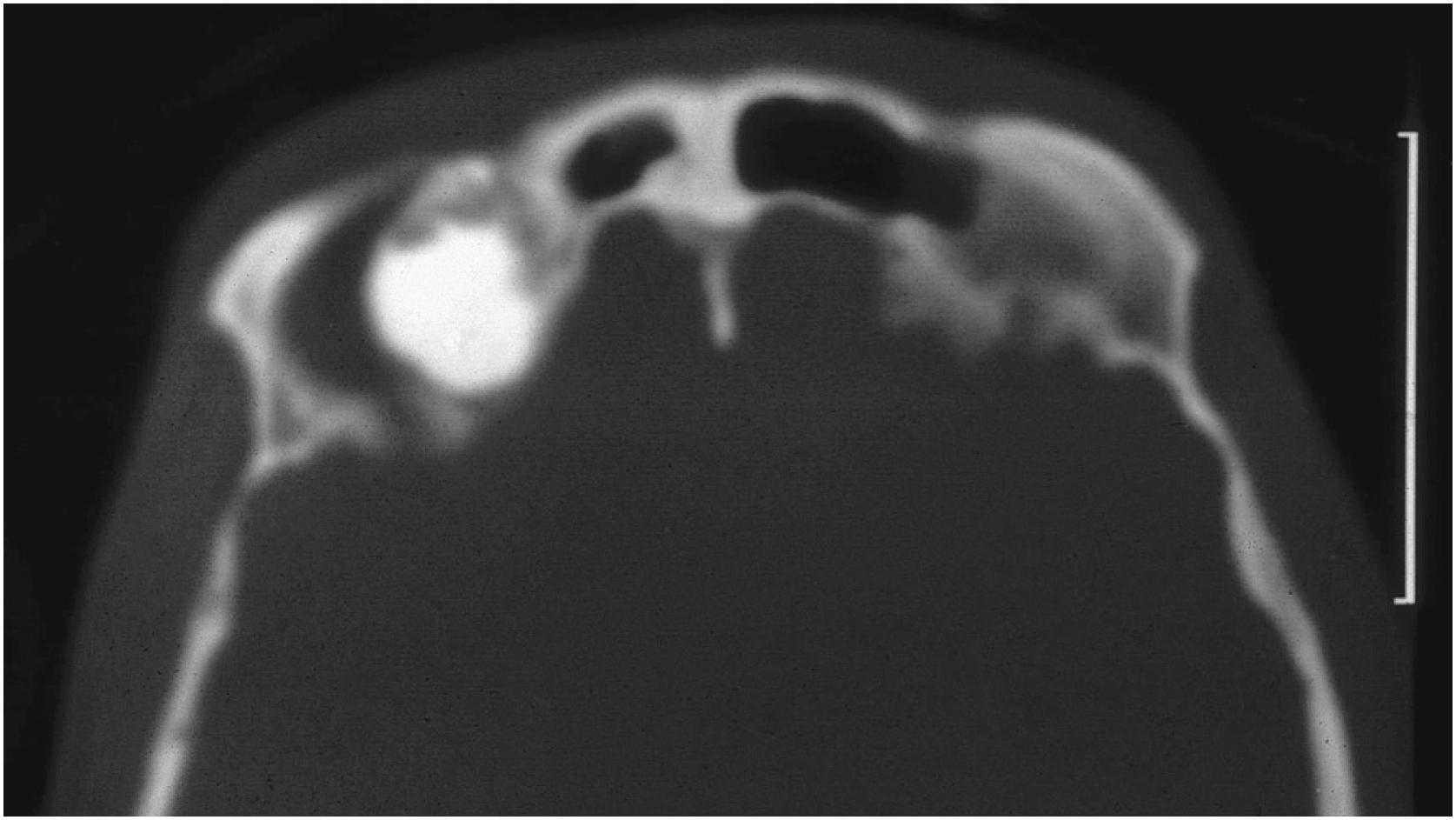
Grossly, most osteomas are 0.5 to 2.0 cm in diameter, round-to-oval, hard, tan-white, and merge seamlessly with the cortical bone from which they arise ( Fig. 16.9 ). Large lesions in the appendicular skeleton are frequently sessile and elongate ( Fig. 16.10 ).
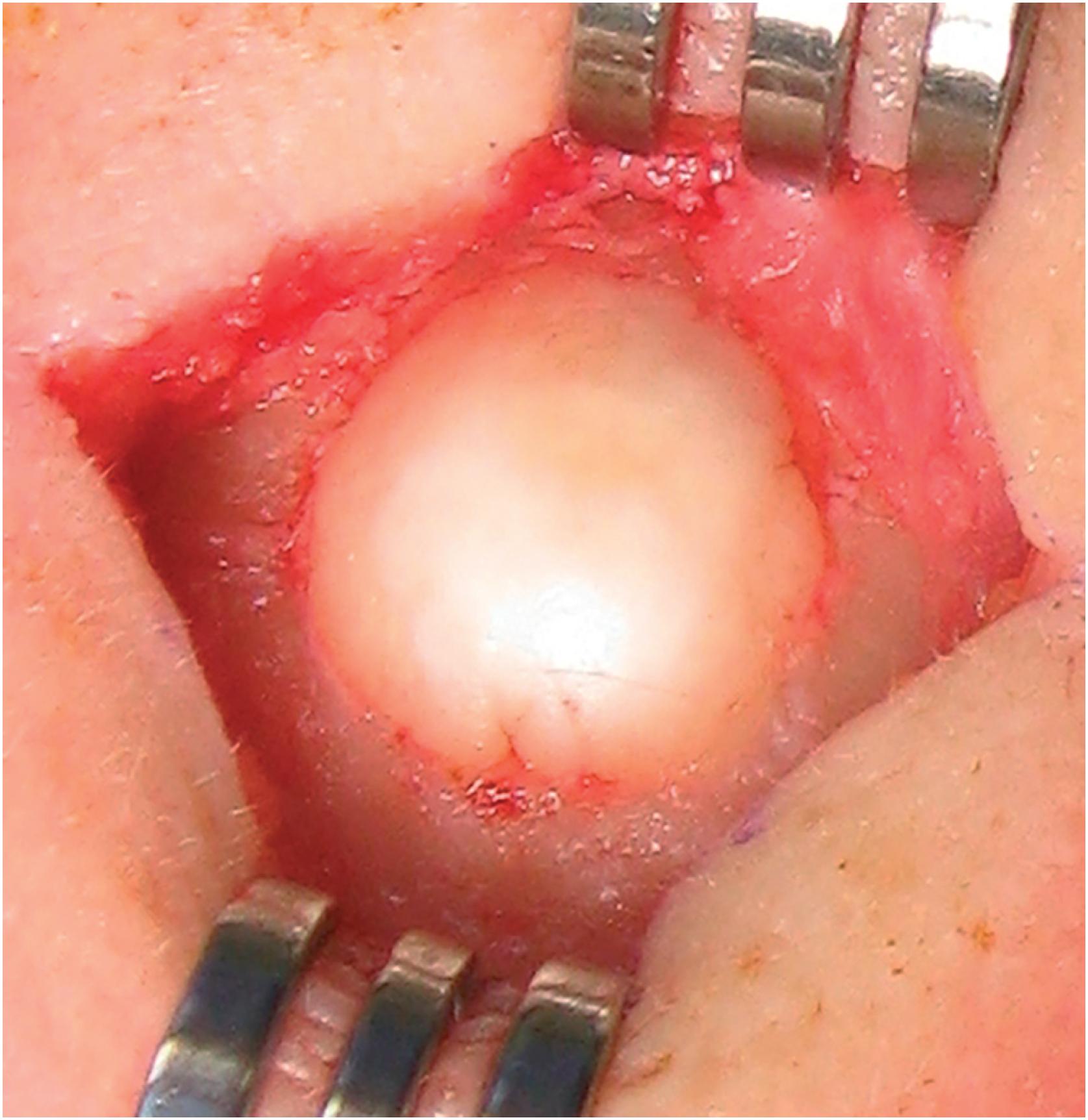
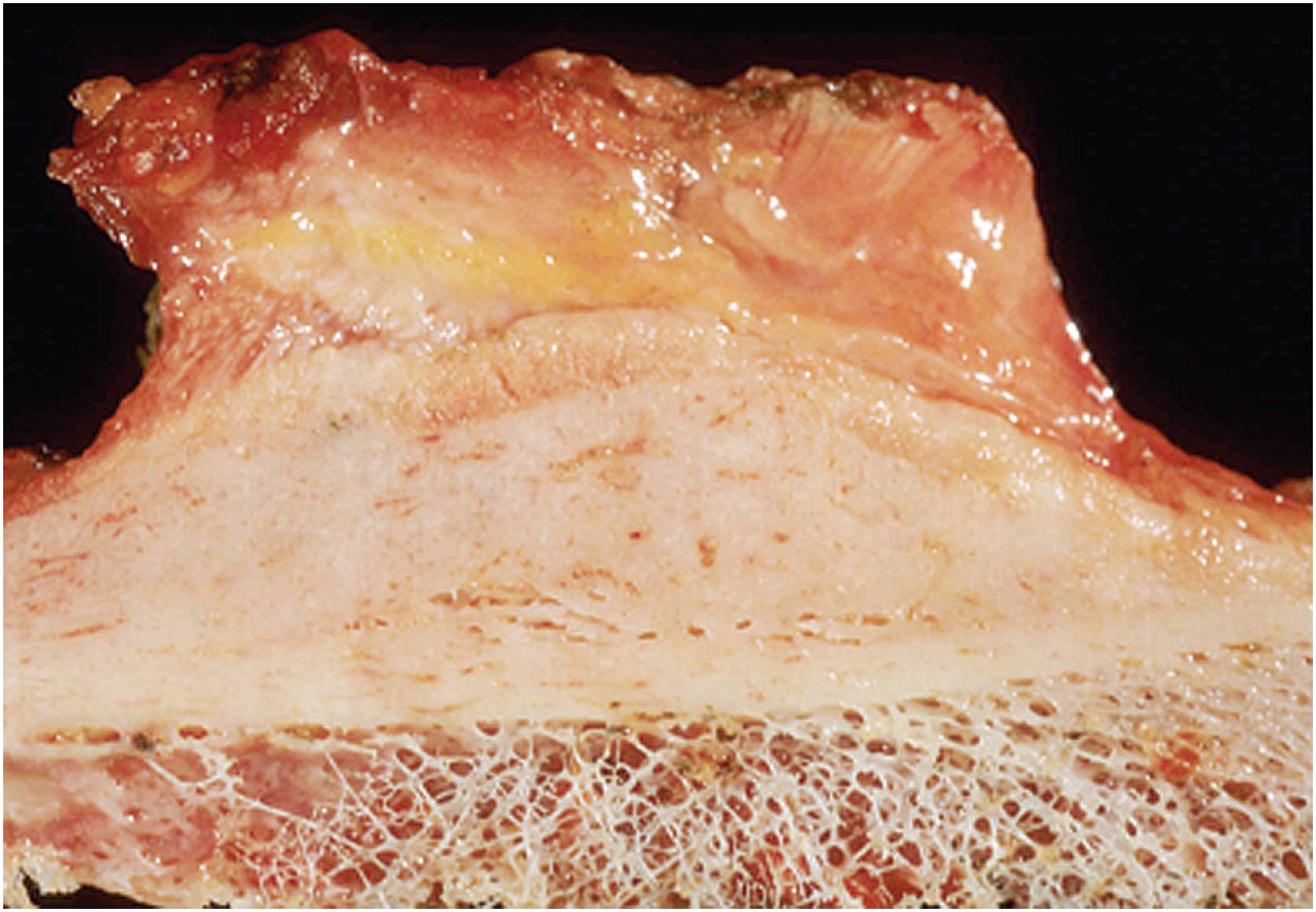
Microscopically, the bone seen in osteomas is lamellar, or an admixture of lamellar and woven, bone that is cortical-like in appearance with perforating vascular channels similar to Haversian systems ( Fig. 16.11 ). In the cancellous variant, the core of the lesion consists of interconnecting, broad trabeculae of bone that are surrounded by fatty marrow. The cells that line the surfaces of the bone are flattened osteoblasts with small, elongate nuclei and sparse amounts of eosinophilic cytoplasm. The osteocytes are small and quiescent in appearance. Infrequently, especially in lesions that are in a stage of rapid growth, the osteoblasts can be large and polyhedral with prominent nuclei and a layer of loose fibrous connective tissue cuffing the adjacent bone.
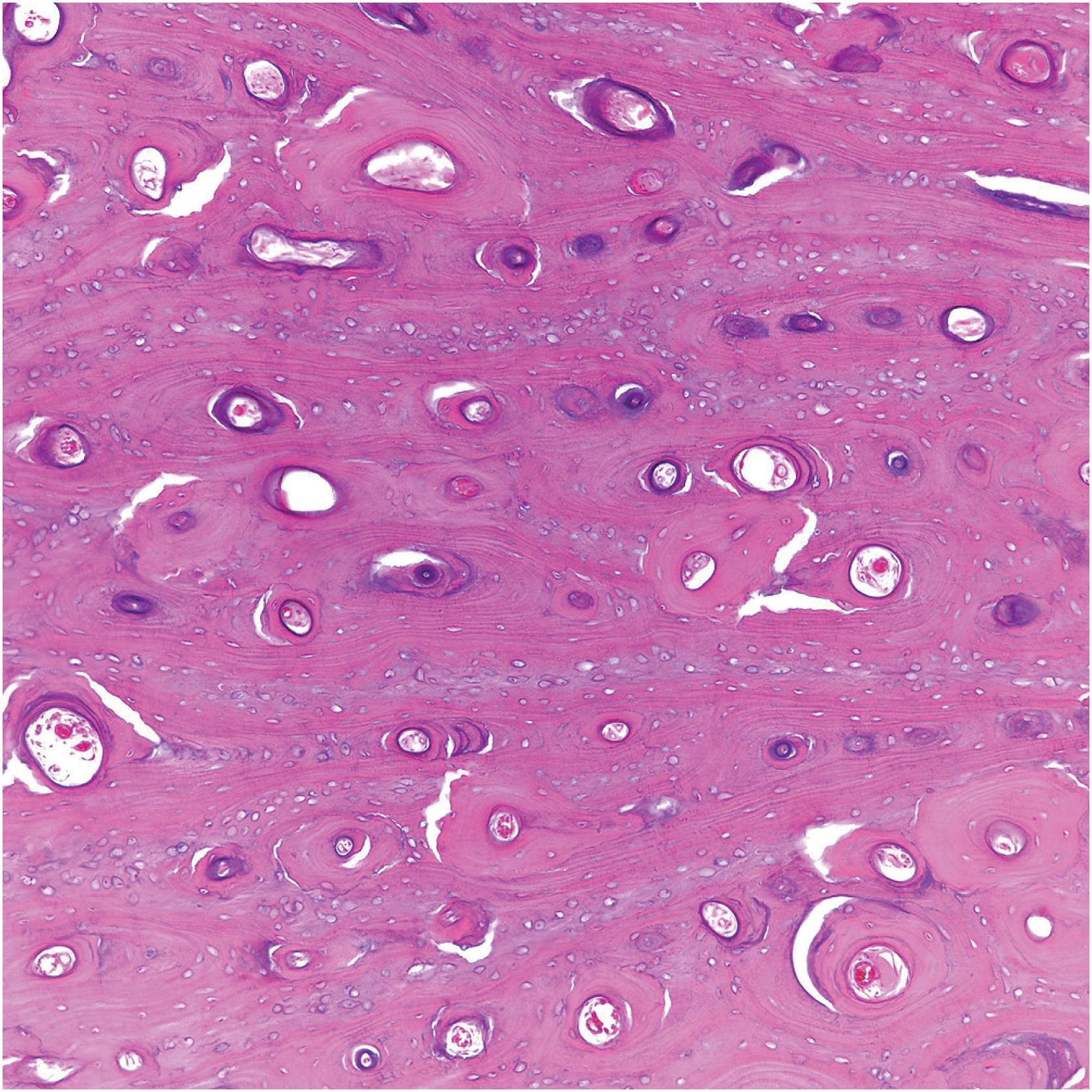
Parosteal osteosarcoma can be clinically confused with osteoma, particularly when they are large and arise within the appendicular skeleton. Histologically, parosteal osteosarcoma is characterized by long, often parallel, trabeculae of woven bone (“streamers”) surrounded by sheets of proliferating spindle cells, which are absent in osteoma. In addition, parosteal osteosarcoma may contain neoplastic cartilage, a feature not present in osteoma. In small biopsies, or samples with adjacent fibrosis, it could rarely be helpful to assess for the presence of MDM2 amplification by ISH or IHC, which is often seen in parosteal osteosarcoma but not in osteoma.
Melorheostosis can resemble osteoma radiographically; however, in melorheostosis, the thickened cortex has the appearance of flowing or dripping candlewax rather than a discrete, ovoid or mushroom-shaped, cortically-based mass, although exceptions occur. Additionally, melorheostosis frequently involves more than one bone and may be associated with localized sclerotic lesions of the skin. In our experience, the bone in a bona fide osteoma and melorheostosis are virtually identical histologically and cannot be confidently distinguished from one another on histologic grounds alone.
Benign bone-forming tumor composed of cortical and less frequently cancellous bone
1% to 3% of adult population; true incidence unknown as many are incidental findings
Craniofacial skeleton especially around sinuses; rarely affects the spine or long bones
Usually solitary but may be multiple in patients with Gardner syndrome
Slow growing and benign
Slight male predominance and diagnosed in mid adulthood
Commonly asymptomatic and incidental finding
Can produce a variety of symptoms depending on location
Surface based, homogeneously radiodense and well demarcated
Gardner syndrome – autosomal dominant; mutations in APC
No treatment unless symptomatic
Symptomatic tumors are conservatively excised
Large osteomas of long tubular bones may require biopsy and excision to exclude a low-grade surface osteosarcoma
Hard, tan-white, mimicking normal bone
Become a Clinical Tree membership for Full access and enjoy Unlimited articles
If you are a member. Log in here